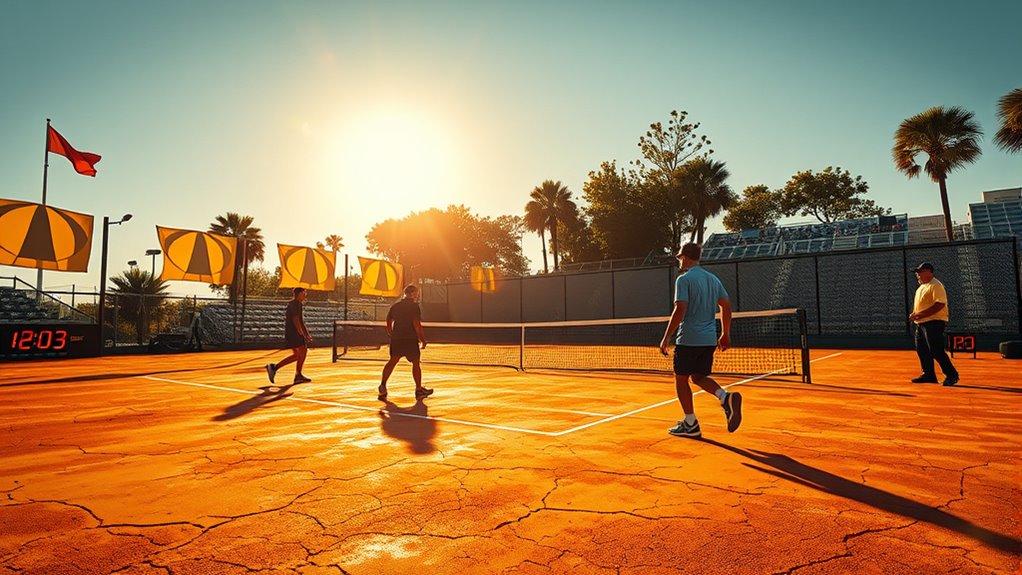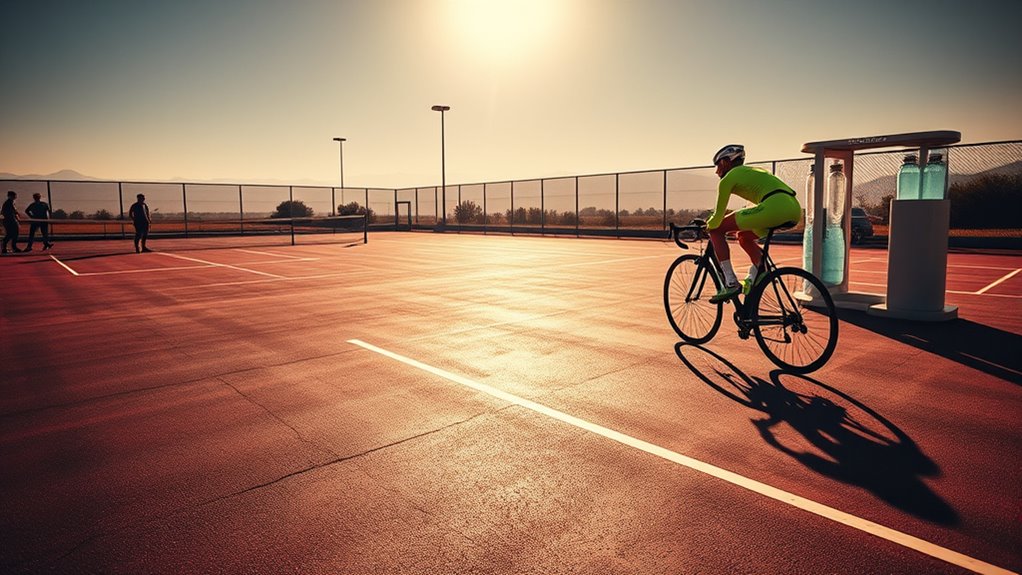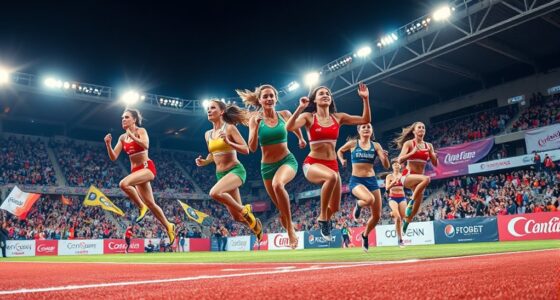Extreme heat protocols are reshaping summer sports worldwide by prioritizing athlete safety over traditional schedules. You’ll see events rescheduled to cooler times, like mornings or evenings, and venues equipped with shaded rest areas and cooling zones. These measures help reduce heat-related illnesses and promote responsible event planning amid climate change. If you want to discover how these safety strategies are transforming outdoor sports environments globally, keep exploring the innovative approaches being adopted.
Key Takeaways
- Sports organizations are implementing heat monitoring and scheduling adjustments to prioritize athlete safety during extreme conditions.
- Enhanced cooling infrastructure and shaded rest areas are being integrated into venues worldwide to prevent heat-related illnesses.
- Global sharing of best practices promotes consistent safety standards and adaptive strategies across diverse summer sports.
- Technological innovations enable real-time heat assessment and data-driven decision-making for event management.
- Emphasizing health-centered approaches shifts focus from traditional practices toward safer, climate-resilient outdoor sporting activities.

Have you ever wondered how summer sports organizations protect athletes from dangerous heat? As temperatures rise globally, organizers are increasingly adopting extreme heat protocols to prioritize athlete safety. These protocols are a vital part of climate adaptation strategies, ensuring that sporting events can proceed without compromising health. You might not notice it during a game, but behind the scenes, officials monitor heat levels closely, adjusting schedules, providing shaded rest areas, and mandating hydration breaks. This proactive approach aims to reduce heat-related illnesses like heat exhaustion or heatstroke, which can strike even the most seasoned athletes.
By implementing these protocols, organizations acknowledge the reality of climate change and its impact on outdoor sports. They recognize that traditional schedules are no longer sufficient in extreme conditions, and adjustments are necessary to protect everyone involved. For instance, some events are rescheduled to cooler times of the day, such as early mornings or late evenings, when heat exposure is less intense. Others incorporate mandatory cooling zones and increased medical readiness to respond swiftly if an athlete shows signs of heat distress. These measures are designed not only to prevent immediate health risks but also to foster long-term athlete safety, promoting a culture that values health over competition.
You may notice that these protocols also influence the planning and execution of summer sports worldwide. Countries are sharing best practices, learning from each other as they adapt to hotter climates. This global shift highlights the importance of climate adaptation in sports, where the focus is on creating safer environments despite environmental challenges. It’s not just about protecting individual athletes; it’s about ensuring the integrity of the sport and the safety of everyone involved. Additionally, governing bodies are investing in research and technology to better predict heatwaves and develop innovative cooling solutions, further enhancing athlete safety during extreme conditions.
The adoption of extreme heat protocols signifies a broader move towards more responsible sports management in a changing climate. It’s a recognition that athlete health should always come first, no matter the sport or location. As these protocols become more widespread, they serve as a reminder that sports organizations have a duty to adapt to environmental realities. You can see this shift reflected in the way events are scheduled, how venues are designed, and how athletes are educated about heat risks. Ultimately, these measures are transforming summer sports into safer, more resilient activities that can withstand the challenges posed by a warming world.
Frequently Asked Questions
How Do Athletes Prepare Physically for Extreme Heat Conditions?
You prepare for extreme heat by focusing on hydration strategies, ensuring you stay well-hydrated before, during, and after activity. Heat acclimation is key—you gradually increase your exposure to heat to boost your body’s ability to handle high temperatures. Doing so helps you maintain performance and reduce heat-related risks. Combining these strategies allows you to adapt safely and perform efficiently, even in the hottest conditions.
What Technology Is Used to Monitor Heat Levels During Competitions?
Think of technology as your personal weather guardian during competitions. Wearable sensors continuously track your body heat, providing real-time data on heat levels, while thermal imaging cameras scan the environment to detect hotspots and guarantee safety. These tools act like a vigilant eye, helping you stay aware of dangerous conditions and make informed decisions. Using such advanced tech keeps you protected, so you can focus on performing at your best under extreme heat.
Are There Long-Term Health Risks Associated With Competing in High Heat?
Competing in high heat can pose long-term health risks, especially if you experience repeated heat exhaustion or dehydration concerns. Over time, these issues may lead to kidney problems, cardiovascular stress, or other health complications. It’s essential to stay hydrated and listen to your body during intense heat conditions. Ignoring these signs could have lasting effects, so prioritize cooling measures and medical attention to protect your long-term well-being.
How Do Extreme Heat Protocols Impact Athlete Performance and Outcomes?
You might think extreme heat protocols hinder performance, but they actually push you to adapt. Proper hydration strategies become essential, helping you stay focused and reduce fatigue. Mental resilience is also tested, encouraging you to stay calm and focused under pressure. These protocols aim to protect your health while maintaining competitive outcomes. So, instead of setbacks, they foster smarter, more resilient athletes capable of performing well even in challenging heat conditions.
What Measures Are Taken to Ensure Fairness When Heat Protocols Are Implemented?
When heat protocols are implemented, you’re protected by strict fairness standards designed to guarantee all athletes compete under equal conditions. Heat safety measures include adjusting schedules, increasing hydration, and providing cooling zones, which help maintain fairness. These steps prevent any athlete from gaining an unfair advantage or facing undue risk during extreme heat, ensuring that everyone’s performance is based on skill rather than environmental factors.
Conclusion
As summer sports embrace extreme heat protocols, you might wonder if these measures are just temporary fixes or signs of a lasting change. With athlete safety now a top priority, it’s clear that adapting to hotter conditions is essential. So, will future summers push us even further to rethink how we play? One thing’s for sure: staying safe and enjoying the game means evolving with the climate, no matter how scorching it gets.










